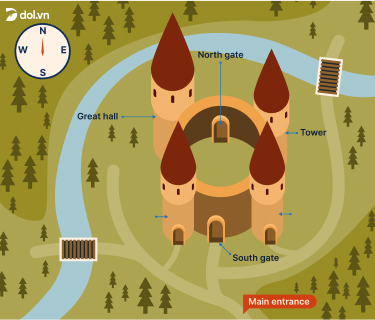Cambridge IELTS 14 - Listening Test 2 With Practice Test, Answers And Explanation
Luyện tập đề IELTS Online Test Cambridge IELTS 14 - Listening Test 2 được lấy từ cuốn sách Cambridge IELTS 14 với trải nghiệm thi IELTS trên máy và giải thích đáp án chi tiết bằng Linearthinking, kèm answer key và list từ vựng IELTS cần học trong bài đọc.
Section
👂️ Bài nghe section 1
PATIENT DETAILS
Example
Name: Julie Anne Garcia
Contact phone:
Date of birth: , 1992
Occupation: works as a
Insurance company: Life Insurance
Details of the problem
Type of problem: pain in her left
When it began: ago
Action already taken: has taken painkillers and applied ice
Other information
Sports played
belongs to a club
goes Regularly
Medical history
injured her last year
no allergies
no regular medication apart from
❓ Tapescript section 1
🔥 Đáp án & giải thích section 1
Giải thích chi tiết
 Xác định cần điền là 1 dãy số chỉ số điện thoại.
Xác định cần điền là 1 dãy số chỉ số điện thoại.
 Khi bạn nghe "And can I have a contact phone number?" là biết đáp án chuẩn bị vào.
Khi bạn nghe "And can I have a contact phone number?" là biết đáp án chuẩn bị vào.
 Sau đó nghe và điền chính xác từng số " It’s 219 442 9785."
Sau đó nghe và điền chính xác từng số " It’s 219 442 9785."
>> Số cần điền là "219 442 9785" 
Section
👂️ Bài nghe section 2

❓ Tapescript section 2
🔥 Đáp án & giải thích section 2
Giải thích chi tiết
 Khi bạn bắt đầu nghe "when Queen Elizabeth I announced that she was going to visit the castle in 1576" là biết đáp án chuẩn bị vào.
Khi bạn bắt đầu nghe "when Queen Elizabeth I announced that she was going to visit the castle in 1576" là biết đáp án chuẩn bị vào.
 Sau đó bạn nghe "it was beginning to look a bit run down, and it was decided that rather than repair the guest rooms, they’d make a new house for her out of wood next to the main hall."
Sau đó bạn nghe "it was beginning to look a bit run down, and it was decided that rather than repair the guest rooms, they’d make a new house for her out of wood next to the main hall."
>> Người ta quyết định rằng thay vì sửa chữa các phòng nghỉ, họ sẽ làm một ngôi nhà mới cho bà
>> Chọn B 
 Một số bạn nghe tiếp sẽ thấy "She stayed there for four nights and apparently it was very luxurious, but unfortunately it was destroyed a few years later by fire."
Một số bạn nghe tiếp sẽ thấy "She stayed there for four nights and apparently it was very luxurious, but unfortunately it was destroyed a few years later by fire."
>> Nó đã bị phá hủy vài năm sau đó bởi hỏa hoạn.
>> Loại C vì hỏa hoạn phá hủy ở vài năm sau chứ không phải 1576
Section
👂️ Bài nghe section 3
❓ Tapescript section 3
🔥 Đáp án & giải thích section 3
Giải thích chi tiết
 Sau khi nghe "about woolly mammoths in our introduction" là biết đáp án chuẩn bị vào.
Sau khi nghe "about woolly mammoths in our introduction" là biết đáp án chuẩn bị vào.
 Nhiều bạn khi nghe "Maybe we could show a video clip of a cartoon about mammoths." thì chọn đáp án C(with a video clip about woolly mammoths)
Nhiều bạn khi nghe "Maybe we could show a video clip of a cartoon about mammoths." thì chọn đáp án C(with a video clip about woolly mammoths)
>> Nhưng chính Rosie đã nói là làm vậy quá trẻ con (childish)
>> Loại C
 Sau đó nghe "Or we could have a diagram, it could be a timeline to show when they lived, with illustrations"
Sau đó nghe "Or we could have a diagram, it could be a timeline to show when they lived, with illustrations"
>> Đáp án ở đây là B (with a timeline showing when woolly mammoths lived) 
 Nhiều bạn khi nghe "Or we could just show a drawing of them walking in the ice" có thể chọn phương án A (with a drawing of woolly mammoths in their natural habit)
Nhiều bạn khi nghe "Or we could just show a drawing of them walking in the ice" có thể chọn phương án A (with a drawing of woolly mammoths in their natural habit)
>> Nhưng Martin cũng đã bác bỏ và nói là hãy trở về phương án trước (a timeline).
Section
👂️ Bài nghe section 4
Many cultures believed that floods and other disasters were involved in the creation of the world.
Many cultures invented and other ceremonies to make the weather gods friendly.
People needed to observe and interpret the sky to ensure their
Around 650 BC, Babylonians started forecasting, using weather phenomena such as
By 300 BC, the Chinese had a calendar made up of a number of connected with the weather
Ancient Greeks
A more scientific approach
Aristotle tried to explain the formation of various weather phenomena.
Aristotle also described haloes and.
Middle Ages
Aristotle’s work considered accurate
Many proverbs, e.g. about the significance of the colour of the , passed on accurate information.
15th-19th centuries
15th century: scientists recognised value of for the first time.
Galileo invented the.
Pascal showed relationship between atmospheric pressure and altitude
From the 17th century, scientists could measure atmospheric pressure and temperature
18th century: Franklin identified the movement of.
19th century: data from different locations could be sent to the same place by.
❓ Tapescript section 4
🔥 Đáp án & giải thích section 4
Giải thích chi tiết
 Xác định từ cần điền là noun chỉ một hoạt động nào đó được nhiều nền văn hóa phát minh để các vị thần có thiện cảm với họ.
Xác định từ cần điền là noun chỉ một hoạt động nào đó được nhiều nền văn hóa phát minh để các vị thần có thiện cảm với họ.
 Sau đó nghe "Generally, weather was attributed to the whims of the gods, as the wide range of weather gods in various cultures shows."
Sau đó nghe "Generally, weather was attributed to the whims of the gods, as the wide range of weather gods in various cultures shows."
>> Nói chung, thời tiết được cho là do những ý tưởng bất chợt của các vị thần, cũng như sự đa dạng của các vị thần thời tiết trong các nền văn hóa khác nhau cho thấy
>> Đang nhắc đến ý thứ 2 nhưng chỉ mới nhắc về các vị thần nên sắp nghe thấy đáp án.
 Tiếp tục nghe "Many ancient civilisations developed rites such as dances in order to make the weather gods look kindly on them."
Tiếp tục nghe "Many ancient civilisations developed rites such as dances in order to make the weather gods look kindly on them."
>> Nhiều nền văn minh cổ đại đã phát triển các nghi thức như khiêu vũ để khiến các vị thần thời tiết có thiện cảm với họ
>> Từ cần điền là "dances" 


